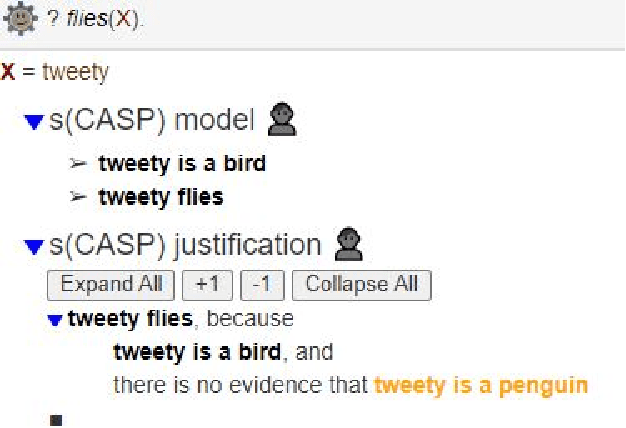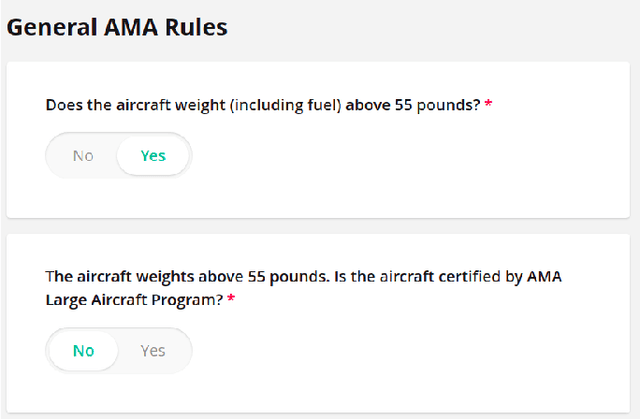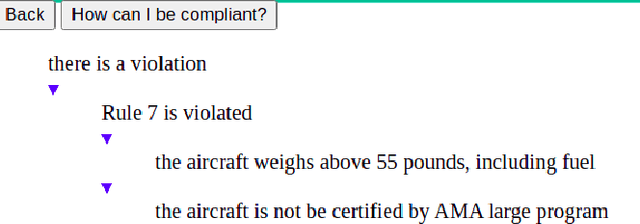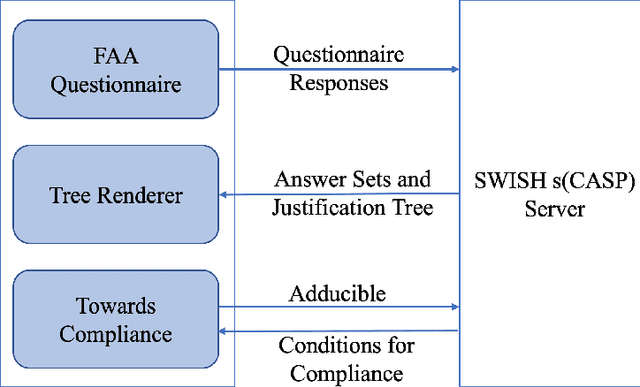Sarat Chandra Varanasi
The University of Texas at Dallas
Automating UAV Flight Readiness Approval using Goal-Directed Answer Set Programming
Aug 25, 2022



Abstract:We present a novel application of Goal-Directed Answer Set Programming that digitizes the model aircraft operator's compliance verification against the Academy of Model Aircrafts (AMA) safety code. The AMA safety code regulates how AMA flyers operate Unmanned Aerial Vehicles (UAVs) for limited recreational purposes. Flying drones and their operators are subject to various rules before and after the operation of the aircraft to ensure safe flights. In this paper, we leverage Answer Set Programming to encode the AMA safety code and automate compliance checks. To check compliance, we use the s(CASP) which is a goal-directed ASP engine. By using s(CASP) the operators can easily check for violations and obtain a justification tree explaining the cause of the violations in human-readable natural language. Further, we implement an algorithm to help the operators obtain the minimal set of conditions that need to be satisfied in order to pass the compliance check. We develop a front-end questionnaire interface that accepts various conditions and use the backend s(CASP) engine to evaluate whether the conditions adhere to the regulations. We also leverage s(CASP) implemented in SWI-Prolog, where SWI-Prolog exposes the reasoning capabilities of s(CASP) as a REST service. To the best of our knowledge, this is the first application of ASP in the AMA and Avionics Compliance and Certification space.
CASPR: A Commonsense Reasoning-based Conversational Socialbot
Oct 11, 2021



Abstract:We report on the design and development of the CASPR system, a socialbot designed to compete in the Amazon Alexa Socialbot Challenge 4. CASPR's distinguishing characteristic is that it will use automated commonsense reasoning to truly "understand" dialogs, allowing it to converse like a human. Three main requirements of a socialbot are that it should be able to "understand" users' utterances, possess a strategy for holding a conversation, and be able to learn new knowledge. We developed techniques such as conversational knowledge template (CKT) to approximate commonsense reasoning needed to hold a conversation on specific topics. We present the philosophy behind CASPR's design as well as details of its implementation. We also report on CASPR's performance as well as discuss lessons learned.
Generating Concurrent Programs From Sequential Data Structure Knowledge Using Answer Set Programming
Sep 17, 2021



Abstract:We tackle the problem of automatically designing concurrent data structure operations given a sequential data structure specification and knowledge about concurrent behavior. Designing concurrent code is a non-trivial task even in simplest of cases. Humans often design concurrent data structure operations by transforming sequential versions into their respective concurrent versions. This requires an understanding of the data structure, its sequential behavior, thread interactions during concurrent execution and shared memory synchronization primitives. We mechanize this design process using automated commonsense reasoning. We assume that the data structure description is provided as axioms alongside the sequential code of its algebraic operations. This information is used to automatically derive concurrent code for that data structure, such as dictionary operations for linked lists and binary search trees. Knowledge in our case is expressed using Answer Set Programming (ASP), and we employ deduction and abduction -- just as humans do -- in the reasoning involved. ASP allows for succinct modeling of first order theories of pointer data structures, run-time thread interactions and shared memory synchronization. Our reasoner can systematically make the same judgments as a human reasoner, while constructing provably safe concurrent code. We present several reasoning challenges involved in transforming the sequential data structure into its equivalent concurrent version. All the reasoning tasks are encoded in ASP and our reasoner can make sound judgments to transform sequential code into concurrent code. To the best of our knowledge, our work is the first one to use commonsense reasoning to automatically transform sequential programs into concurrent code. We also have developed a tool that we describe that relies on state-of-the-art ASP solvers and performs the reasoning tasks involved to generate concurrent code.
* In Proceedings ICLP 2021, arXiv:2109.07914. arXiv admin note: substantial text overlap with arXiv:2011.04045
Knowledge-Assisted Reasoning of Model-Augmented System Requirements with Event Calculus and Goal-Directed Answer Set Programming
Sep 10, 2021
Abstract:We consider requirements for cyber-physical systems represented in constrained natural language. We present novel automated techniques for aiding in the development of these requirements so that they are consistent and can withstand perceived failures. We show how cyber-physical systems' requirements can be modeled using the event calculus (EC), a formalism used in AI for representing actions and change. We also show how answer set programming (ASP) and its query-driven implementation s(CASP) can be used to directly realize the event calculus model of the requirements. This event calculus model can be used to automatically validate the requirements. Since ASP is an expressive knowledge representation language, it can also be used to represent contextual knowledge about cyber-physical systems, which, in turn, can be used to find gaps in their requirements specifications. We illustrate our approach through an altitude alerting system from the avionics domain.
* In Proceedings HCVS 2021, arXiv:2109.03988
SQuARE: Semantics-based Question Answering and Reasoning Engine
Sep 22, 2020



Abstract:Understanding the meaning of a text is a fundamental challenge of natural language understanding (NLU) and from its early days, it has received significant attention through question answering (QA) tasks. We introduce a general semantics-based framework for natural language QA and also describe the SQuARE system, an application of this framework. The framework is based on the denotational semantics approach widely used in programming language research. In our framework, valuation function maps syntax tree of the text to its commonsense meaning represented using basic knowledge primitives (the semantic algebra) coded using answer set programming (ASP). We illustrate an application of this framework by using VerbNet primitives as our semantic algebra and a novel algorithm based on partial tree matching that generates an answer set program that represents the knowledge in the text. A question posed against that text is converted into an ASP query using the same framework and executed using the s(CASP) goal-directed ASP system. Our approach is based purely on (commonsense) reasoning. SQuARE achieves 100% accuracy on all the five datasets of bAbI QA tasks that we have tested. The significance of our work is that, unlike other machine learning based approaches, ours is based on "understanding" the text and does not require any training. SQuARE can also generate an explanation for an answer while maintaining high accuracy.
* In Proceedings ICLP 2020, arXiv:2009.09158
 Add to Chrome
Add to Chrome Add to Firefox
Add to Firefox Add to Edge
Add to Edge